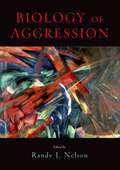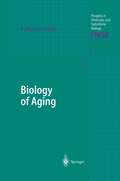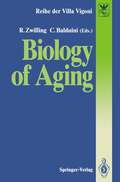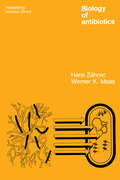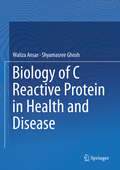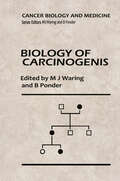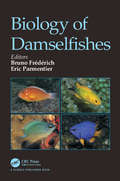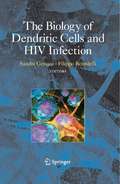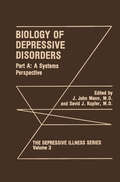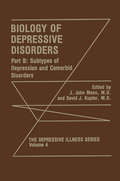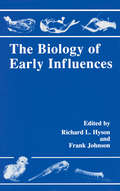- Table View
- List View
The Biology of Ageing: A Practical Handbook
by Gurcharan Rai Aza AbdullaOne of the problems geriatricians are confronted with in everyday clinical practice is differentiating disease from the process of old age. The challenges of ageing require a better understanding of the essential biology of ageing in order to separate ageing from disease, and indeed ageing made worse by disease. Although the topic is large and diverse, this practical and easy-to-read reference book contains vital information on the biology of ageing. It provides a concise understanding of the changes that occur and focuses on the clinical implications of ageing. MCQs are featured throughout for revision and examination practice. The Biology of Ageing provides the reader with: . a learning guide on the biology of ageing through an overview of the changes that occur at both cellular and system levels . knowledge of how biological changes of ageing impact on physiology and the clinical relevance in medical practice . a practical consideration of these changes in disease presentations and how these changes may impact on disease management. This full-colour guide featuring slides, MRIs, figures and photographs is ideal for doctors training in geriatric medicine, practising geriatricians and those with an interest in management of older people.
Biology of Aggression
by Randy J. NelsonUnchecked aggression and violence take a significant toll on society. Even if we manage to avoid being the direct victim of a violent act, the effects of aggression and violence reach us all: We hear about the mauling of a woman by an aggressive dog, our children are bullied at school, or we deal with impulsive violence while commuting to work or attending a sporting event. Reflecting psychology in general, the dominant roles of learning and environmental influences - both social and nonsocial - have traditionally been prominent in discussions of the etiology of human aggression. Biological factors have not been considered sufficiently important to investigate in the search for ways of dealing with human aggression or violence. With recent advances in pharmacology and genetic manipulation techniques, however, new interest has developed in the biological mechanisms of both non-human and human aggression. Although aggression is certainly a complex social behavior with multiple causes, molecular biological factors should not be overlooked, as they may well lead to interventions that prevent excess aggressive behaviors. The primary goal of this book is to summarize and synthesize recent advances in the biological study of aggression. As most aggressive encounters among human and non-human animals represent a male proclivity, the research in this book describes and discusses studies using the most appropriate murine model: testosterone-dependent offensive inter-male aggression, which is typically measured in resident-intruder or isolation-induced aggression tests. The research also emphasizes various molecules that have been linked to aggression tests. The research also emphasizes various molecules that have been linked to aggression by the latest gene-targeting and pharmacological techniques. Although the evidence continues to point to androgens and serotonin (5-HT) as major hormonal and neurotransmitter factors in aggressive behavior, recent work with GABA, dopamine, vasopressin, and other factors, such as nitric oxide, has revealed significant interactions with the neural circuitry underlying aggression. This book is organized according to levels of analysis. The first section examines the genetic contributions to aggression in species ranging from crustaceans to humans. The section summarizes the involvement of various neurotransmitters and neuromodulators in aggressive behavior. The third section summarizes the influence of hormones on aggression, primarily in humans. All chapters emphasize future directions for research on aggression and reveal important domains that have received comparatively less attention in this literature. Considered together, these chapters provide up-to-date coverage of the biology of aggression by some of the leading authorities currently working in this field. Biology of Aggression will direct future research to continue the recent advances in the pharmacological and genetic approaches to understanding aggression and violence. It promises to be a valuable resource for professional and student researchers in neuroscience, psychiatry, cognitive and developmental psychology, behavioral biology, and veterinary medicine.
Biology of Aggression
by Randy J. NelsonUnchecked aggression and violence take a significant toll on society. Even if we manage to avoid being the direct victim of a violent act, the effects of aggression and violence reach us all: We hear about the mauling of a woman by an aggressive dog, our children are bullied at school, or we deal with impulsive violence while commuting to work or attending a sporting event. Reflecting psychology in general, the dominant roles of learning and environmental influences - both social and nonsocial - have traditionally been prominent in discussions of the etiology of human aggression. Biological factors have not been considered sufficiently important to investigate in the search for ways of dealing with human aggression or violence. With recent advances in pharmacology and genetic manipulation techniques, however, new interest has developed in the biological mechanisms of both non-human and human aggression. Although aggression is certainly a complex social behavior with multiple causes, molecular biological factors should not be overlooked, as they may well lead to interventions that prevent excess aggressive behaviors. The primary goal of this book is to summarize and synthesize recent advances in the biological study of aggression. As most aggressive encounters among human and non-human animals represent a male proclivity, the research in this book describes and discusses studies using the most appropriate murine model: testosterone-dependent offensive inter-male aggression, which is typically measured in resident-intruder or isolation-induced aggression tests. The research also emphasizes various molecules that have been linked to aggression tests. The research also emphasizes various molecules that have been linked to aggression by the latest gene-targeting and pharmacological techniques. Although the evidence continues to point to androgens and serotonin (5-HT) as major hormonal and neurotransmitter factors in aggressive behavior, recent work with GABA, dopamine, vasopressin, and other factors, such as nitric oxide, has revealed significant interactions with the neural circuitry underlying aggression. This book is organized according to levels of analysis. The first section examines the genetic contributions to aggression in species ranging from crustaceans to humans. The section summarizes the involvement of various neurotransmitters and neuromodulators in aggressive behavior. The third section summarizes the influence of hormones on aggression, primarily in humans. All chapters emphasize future directions for research on aggression and reveal important domains that have received comparatively less attention in this literature. Considered together, these chapters provide up-to-date coverage of the biology of aggression by some of the leading authorities currently working in this field. Biology of Aggression will direct future research to continue the recent advances in the pharmacological and genetic approaches to understanding aggression and violence. It promises to be a valuable resource for professional and student researchers in neuroscience, psychiatry, cognitive and developmental psychology, behavioral biology, and veterinary medicine.
Biology of Aging (Progress in Molecular and Subcellular Biology #30)
by Alvaro Macieira-CoelhoThe survival of the human species has improved significantly in modern times. During the last century, the mean survival of human populations in developed countries has increased more than during the preceding 5000 years. This improvement in survival was accompanied by an increase in the number of active years. In other words, the increase in mean life span was accompanied by an increase in health span. This is now accentuated by progress in medicine reducing the impact of physiologic events such as menopause and of patho logical processes such as atherosclerosis. Up to now,research on aging, whether theoretical or experimental, has not contributed to improvement in human survival. Actually, there is a striking contrast between these significant modifications in survival and the present knowledge of the mechanisms of human aging. Revealed by this state of affairs are the profound disagreements between gerontologists in regard to the way oflooking at the aging process. The definition of aging itself is difficult to begin with because of the variability of how it occurs in different organisms.
Biology of Aging (Reihe der Villa Vigoni #1)
by Robert Zwilling Cesare Balduinibhe aim of the book was not to focus the age-dependent modifications of one specific biological systems or phenomena, but the attempt was pursued to cover several fields in which the biological research on aging is going on. The fundamental purpose of this planning was to offer the PhD students an advanced text that could raise the possibility of an interdisciplinary discussion on a wide and complex field that is very suitable to be utilized as an example of the connection existing between advanced teaching and experimental research.
Biology of Aging and Development (FASEB Monographs #3)
by Gertruida Thorbecke"e of the reasons for all the F ASEB Societies to meet yearly is the possibility O to interrelate recent progress in diverse areas of research. The F ASEB Conferences have been organized to promote such interdisciplinary approaches. They center around a basic theme with the aim of discussing active research, in cluding widely divergent approaches, towards a better understanding of a general biological phenomenon. Because of the mounting interest in the subject of aging and development, this has been chosen as the theme for this year's symposia. We have necessarily been limited in the number of topics that could be covered. In our choice we have attempted to' select those facets of the main subject which at this time are gen erating active research interest among our membership. We have included invited speakers from abroad, such as Drs. Goldstein, Liew and Miller from Canada and Drs. Wolpert, Holliday and Williamson from England. I am sorry to say that the two speakers that we had invited from Russia, Dr. Frolkis, and from Czechoslovakia, Dr. Sterzl, were unable to attend.
Biology of Amphibian Tumors (Recent Results in Cancer Research #1969)
by Merle MizellNew Orleans has a distinguished history as a center for medical and biological learning, a history shared by Tulane University, its School of Medicine, and its Bio logical and Medical Sciences departments. This background made it especially fitting that the University, in conjunction with the Cancer Association of Greater New Orleans, Inc. and the National Cancer Institute, should sponsor the "Symposium: Biology of Amphibian Tumors" held October 28, 29, 30, 1968. The University wishes to express its appreciation to the Cancer Association for its assistance in making the Symposium possible and to acknowledge the support made available through the Bio medical Sciences Support Grant program of the National Institutes of Health. As the title of this volume indicates, the Symposium yielded valuable results in the area of cancer research and it stands to stimulate further efforts in this most important field. Some notion of the impact of this symposium is suggested by the broad range of the 200 participants it attracted. They came not only from the breadth and length of the U.S., but from abroad, from France, England, Austria, and Italy.
Biology of Antibiotics (Heidelberg Science Library)
by Hans Zähner Werner K. MaasThis book is based on Hans Zahner's Biologie der Antibiotica, published in 1965. There is a vast literature on antibiotics, covering chemical, phar macological, and clinical aspects. We have made no attempt to cover this literature comprehensively. Our effort is directed toward discuss ing antibiotics as biological agents. They are substances produced by living cells, yet they are able to inhibit the growth of living cells - in many cases even the cells that produce them. We have taken this apparent biological paradox as our point of departure and have tried to look in this light at the production of antibiotics and at their mode of action. In a sense antibiotics are comparable to mutations. They are useful as tools in the study of metabolism by blocking specific reactions. At the same time their mode of origin and their effects on the organisms that produce them are interesting problems in their own right. We have tried to incorporate both aspects into our consider ations. This little book, designed for biology students and medical stu dents, provides them with a framework into which to fit more specialized and detailed information on antibiotics.
Biology of Brain Tumour: Proceedings of the Second International Symposium on Biology of Brain Tumour (London, October 24–26, 1984)
by David G. T.Thomas Michael D. WalkerThis volume contains the proceedings of the Second International Symposium on Biology of Brain Tumour. The first Symposium was held in 1979 at Gardonne Riviera, Italy. This meeting was planned in order to coincide with the lOOth Anniversary of the first reported operation for glioma in London on November 25, 1884. Since the first meeting, the field of neuro-oncology has made remarkable progress in understanding both basic and clinical factors of significance to patients with brain tumor. While the earlier meeting dealt to a large extent with clinically oriented studies, this symposium was more heavily weighted toward the biology of brain tumour and improving our understanding at the physiologic, biochemical, pharmacologic, and cellular level. The meeting was divided according to scientific content into presentations and discussions as well as posters for more leisurely viewing, so as to allow the main themes of the meeting to sequentially develop. The first session dealt extensively with neuro-oncology at the molecular level and included considerable discus sion of material related to the babic biochemical milieu in which tumors originate, proliferate, and eventually destroy the brain. Classic neuropathology has been the mainstay of tumor identification and characteriza tion, however, the process of classification has become much more complex. The availability of a variety of new tools has allowed investigation into the validity of the more traditional classification systems as well as the development of newer biologically related concepts.
Biology of C Reactive Protein in Health and Disease
by Waliza Ansar Shyamasree GhoshThis book offers a comprehensive study of C-reactive protein (CRP) belonging to the pentraxin family, including a brief history of CRP, its structure, synthesis and evolution. Focusing on the emerging role of CRP and its clinical application in the field of disease biology, it details the pathophysiological role of CRP in a host of diseases such as cardiovascular disease, diabetes, cancers, rheumatoid arthritis and infectious diseases and others. It also discusses the role of innate immunity and acute phase response (APR) and their key mediators in the host body in response to tissue injury, infection, trauma or surgery, immunological disorders or neoplastic growth. CRP’s significance in inflammation is highlighted, and its importance as a clinical marker in cardiovascular disease, its functional significance in Leishmania and Plasmodium infections, its association with the development of insulin resistance in type 2 diabetes mellitus, and its role in cancer are discussed in detail. The book also includes clinical data studies and presents the latest research advances to further readers’ understanding of CRP.
The Biology of Cancer: A New Approach
by P.R. BurchOf all the diseases that afflict mankind those described as 'cancer' evoke the strongest emotions. 'Cancer' connotes pain, protracted suffering, hideous growth and death. It is widely and justifiably feared. In medically advanced countries, malignant neoplasms (the official term for cancers) account for a substantial proportion of all deaths. Out of a total of 575194 deaths in Eng land and Wales during the year 1970, some 117076-or 20·4 per cent-were attributed to neoplasms of one kind or another (Registrar General, 1972). Diseases of the circulatory system-mainly arteriosclerotic and degenerative heart disease-claimed many more victims, being responsible for some 50·6 per cent of all deaths, but our psyche evidently responds more to the manner of the disease than to the number of deaths it causes. Many of us will have witnessed the deterioration of a close friend or relative suffering from an inoperable cancer: such an experience induces a sense of hopelessness and helplessness. The feelings of sorrow and distress can be a powerful stimulus to action and they often result in dedicated and tireless research efforts. At the same time, the very strength and depth of the commitment may sometimes be incompatible with the detachment that is needed for objective analysis and a wise strategy. Not too rigorously, we reason that if only we can discover the causes of cancer, then our problems will be solved and our agonies relieved. Remove the cause: prevent the cancer. The logic exerts an irresistible appeal.
The Biology of Cancer
by Janice GabrielThe application of biology to the delivery of cancer care is playing an increasingly important role in the management of this group of diseases. Although there are a plethora of specialist cancer biology books, they are not aimed at nursing students and practising nurses. The aim of this book is to be an informative text for students, newly qualified nurses and practising oncology/palliative care nurses. It is also hoped that it will be a useful text for other health care professionals working in the field of cancer, so that the common questions asked by patients, and their families, can be answered with a clear understanding of the latest advancements in the management of an individual' s care.
The Biology of Cancer
by Janice Ann GabrielAdvances in research and the treatment of cancer mean that more patients and their carers are asking healthcare professionals about the latest treatments and how they may be of benefit. It is essential that staff working with cancer patients understand fully how these new treatments work in order to disseminate timely and appropriate information to patients. The application of biology to the delivery of cancer care is playing an ever-increasing role in the management of these diseases. The Biology of Cancer: Second Edition provides details of the most recent developments in cancer care and is divided into three sections: Understanding Cancer – examines predisposing factors to developing cancer, diagnosis and its implications on the individual and society. The Science of Cancer – a closer look at the cell, genetics, the immune system, tumour markers and monoclonal antibodies. Research and Treatment – exploring translational oncology, applying research methodology to cancer research and research ethics relating to cancer. This fully updated edition also looks at evidence-based research that can be translated directly to patient care and gives details recent developments. Written by experienced, practicing healthcare professionals, The Biology of Cancer: Second Edition can easily be applied to patient care. It is an informative text for students, newly qualified nurses and practising oncology/palliative care nurses.
The Biology of Cancer (Second Edition) (PDF)
by Robert WeinbergThoroughly updated and incorporating the most important advances in the fast-growing field of cancer biology, The Biology of Cancer, Second Edition, maintains all of its hallmark features admired by students, instructors, researchers, and clinicians around the world. The Biology of Cancer is a textbook for students studying the molecular and cellular bases of cancer at the undergraduate, graduate, and medical school levels. The principles of cancer biology are presented in an organized, cogent, and in-depth manner. The clarity of writing, supported by an extensive full-color art program and numerous pedagogical features, makes the book accessible and engaging. The information unfolds through the presentation of key experiments that give readers a sense of discovery and provide insights into the conceptual foundation underlying modern cancer biology. The new Second Edition has been comprehensively revised and updated to include major advances in cancer biology over the past six years.
Biology of Carcinogenesis (Cancer Biology and Medicine #1)
by B. A. J.Ponder M. J. WaringThere is no shonage of books on cancer. Why publish another? Simply because the subject is important: possibly the most important challenge facing medicine today, and consequently the focus of one of the faslest-growing areas of fundamental biological research. The quest to understand and control cancer is so absorbing that from time 10 time we really need to pause for a moment and try to take stock of the situation. Given the sheer breadth of cancer-related research that is not an easy task. This book, together with its planned successors in the series Cancer Biology and Medicine. represents our attempt to draw back from the bench or the bedside for a moment and take a slightly longer look at what we are doing, what we are trying to do, and where we stand. It is impossible to be comprehensive or even representative of more than a fraction of relevant knowledge. but that is no excuse for not trying to see things in perspective. Accordingly we set out to persuade a number of our colleagues to join us in writing a book which might admit a little fresh air into the confined atmosphere within which we mostly work: a glimpse, perhaps. of fresh vistas.
Biology of Chlamydia (Current Topics in Microbiology and Immunology #412)
by Georg HäckerThe genus Chlamydia encompasses a number of species of obligate intracellular bacteria, including important human pathogens like the most common bacterial agent of sexually transmitted disease. This volume reviews current knowledge of chlamydial biology, covering the unusual structure of the bacteria – which alternate between metabolically almost inactive and fast-dividing forms. It also discusses the ways in which Chlamydia manipulates the host cytoskeleton and subverts the host cell’s defence, and illustrates how genomics have begun to uncover the diversity and complexity of chlamydial strains that look very similar but may cause distinct forms of disease. Further, it describes how techniques are now finally being established that can genetically modify Chlamydia, and discusses why such modification is still very difficult and what progress we can expect. Lastly, it presents our current understanding of chlamydial disease: what do we know about chronic infections, what are the mechanisms of inflammatory damage, and what are the prospects of a vaccine? Written be specialists in these various areas, the book is a valuable work of reference for students and scientists with an interest in the molecular, cellular and immunobiology of these fascinating bacteria.
The Biology of Complex Organisms: Creation and Protection of Integrity
by Klaus EichmannOn December 6, 1961, a contract was signed by which the research institute of the Wander AG in Freiburg became the Max-Planck-Institut fUr Immunbiologie. The transfer of ownership took place during a happy expansion phase of the Max-Planck Society in which a growing economy in Germany allowed the foundation of many new research institutes by the Max-Planck-Society and other organizations. Nevertheless, it was a remarkable event. The acquisition by an academic organization of an institute formerly operated by an industrial company was rather unusual, not to speak ofthe fact that not only the facilities but also the entire scientific personnel were taken over. Retrospectively, the 40 years of the institute in the Max-Planck Society can be divided into 2 very different phases of 20 years each. The first 20 years were characterized by a continuation of the research that had begun in the Wander institute and centered on the structure and function of the bacterial compound endotoxin. During the second 20 years, the institute more than doubled in size and developed into an interdisciplinary research center that focuses on the development and organization of multicellular systems by combining studies in two fields of research: immunology and developmental biology. th The 40 anniversary of the foundation of the Max-Planck-Institute was celebrated by a ceremony including a scientific symposium. The first part of this volume presents the lectures given at the symposium by six leading biologists.
Biology of Damselfishes
by Bruno Frédérich Prof. Eric ParmentierDamselfishes (Pomacentridae) are highly conspicuous, diurnal inhabitants of mainly reef areas, capturing the attention of many scientists. Their high diversity and the many interesting characteristics dealing with their way of life (sound production, breeding biology, sex change, farming and gregarious behavior, settlement, diet, habitat) easily explain how this group is continually kept in the limelight and is the subject of numerous studies. This book gathers the data dealing with damselfish morphology, physiology, behavior, ecology and phylogeny.It contains 14 chapters written by renowned scientists.
Biology of Damselfishes
by Eric Parmentier Bruno FrédérichDamselfishes (Pomacentridae) are highly conspicuous, diurnal inhabitants of mainly reef areas, capturing the attention of many scientists. Their high diversity and the many interesting characteristics dealing with their way of life (sound production, breeding biology, sex change, farming and gregarious behavior, settlement, diet, habitat) easily explain how this group is continually kept in the limelight and is the subject of numerous studies. This book gathers the data dealing with damselfish morphology, physiology, behavior, ecology and phylogeny.It contains 14 chapters written by renowned scientists.
The Biology of Dendritic Cells and HIV Infection
by Sandra Gessani Filippo BelardelliDendritic cells play the most vital part in inducing anti-viral immune responses in HIV and AIDS among many other viruses. Research on dendritic cells (DCs) is emerging as a fundamental aspect for the comprehension of the mechanisms underlying the pathogenesis of viral diseases. This volume focuses on the role of DCs in the pathogenesis and immunity of HIV-1 infection. It is the only comprehensive volume on pathogenesis and immunity of Dendritic Cells that also focuses on HIV.
Biology of Depressive Disorders. Part A: A Systems Perspective (The Depressive Illness Series #3)
by David J. Kupfer J. JohnMannThis volume is the third in a series on depressive illness. The first volume, entitled Phenomenology of Depressive Illness, is devoted to a de scription of depressive illness from a variety of perspectives that include those of the patient, the clinician, and the psychiatric researcher. It de scribes the major subtypes of depressive illness and places them in the context of the life cycle. The second volume in this series is entitled Models of Depres sive Disorders: Psychological, Biological, and Genetic Perspectives. This volume describes several major models of depressive disorders, in cluding genetic, cognitive, interpersonal, intrapsychic, and neurobio logical models. The third and fourth volumes deal with the biology of affective disorders in detail. These volumes are distinguished by a triaxial ap proach. In Volume III the biology of affective disorders is described from the perspective of individual transmitter systems and neurophysi ologic and biologic processes. In Volume IV the biology of depression is addressed from the vantage point of symptom components of de pression, and similarities and differences in the biology of depression are described compared to other psychiatric disorders with clinically overlapping features such as anxiety disorders or eating disorders. The effects on biology of comorbid conditions such as anxiety, personal ity disorders, alcoholism, and eating disorders are reviewed. These ap proaches incorporate issues of state versus trait.
Biology of Depressive Disorders. Part B: Subtypes of Depression and Comorbid Disorders (The Depressive Illness Series #4)
by J. John Mann David J. KupferThe Biology of DNA Tumor Viruses: With an Introduction by Renato Dulbecco (Milestones in current research)
by Samuel SchiminovichMilestones in Current Research is a series of reprint collections dis tinguished from other such publications by new concepts in preparation, presentation, and intent. The aim of each volume is to gather for a given field the seminal contributions that have defined and shaped the trends within the most active areas of current research. The selections for each volume and the structure of the book have been determined with the help of a novel tech nique of bibliographic analysis and have then been presented to an acknowl edged scientific authority for minor adjustments and the writing of an In troduction. These introductions will lend historic perspective to the material selected for each volume. The bibliographic analysis used tends to select papers central to the areas of current research within, roughly, the last decade and is a systematic procedure for depicting, delineating, and covering all such areas over a wide spectrum of scientific research. It is hoped that with this procedure it will be possible to achieve an objectivity, authority, and thoroughness not reached by others and that the timeliness of the volumes will not be limited to just a few years. Each volume should have the permanent value of a historical statement and yet be suf ficiently interesting to active researchers in the field as well as to students exploring the quiet way in which the relentless drama of research unfolds in the journal literature.
The Biology of Early Influences
by Richard L. Hyson Frank JohnsonThe underlying theme of this book the role of experience in the development of the nervous system. It is now widely acknowledged that there are a variety of organi- environment interactions that guide the development of the nervous system. The popular press has also picked up on this theme and parents are being advised to enrich their child's sensory experience as early as possible. The importance of experience in development is so well accepted that it has begun to dictate public policy. In 1997, the President and First Lady hosted "The White House Conference on Early Childhood Development and Learning: What New Research on the Brain Tells Us About Our Youngest Children. " Along with this conference came a reemphasis on programs directed at enriching the en- ronment of America's youth. In some cases laws have been passed to assure enhanced early experience. In Georgia, the former governor proposed sending newborn children home from the hospital with classical music CDs. This received some praise, but was also ridiculed by others who felt the policy was not justified by the available scientific evidence. Here in Florida, enhanced "brain development activities" are mandated for sta- funded child care facilities. Chapter 402. 25 of the 1998 State of Florida Statues reads (emphasis added): Infants and toddlers in state-funded education and care programs; brain development activities.
The Biology of Early Life Stress: Understanding Child Maltreatment and Trauma (Child Maltreatment Solutions Network)
by Jennie G. Noll Idan ShalevThis innovative collection extends the emerging field of stress biology to examine the effects of a substantial source of early-life stress: child abuse and neglect. Research findings across endocrinology, immunology, neuroscience, and genomics supply new insights into the psychological variables associated with adversity in children and its outcomes. These compelling interdisciplinary data add to a promising model of biological mechanisms involved in individual resilience amid chronic maltreatment and other trauma. At the same time, these results also open out distinctive new possibilities for serving vulnerable children and youth, focusing on preventing, intervening in, and potentially even reversing the effects of chronic early trauma.Included in the coverage:Biological embedding of child maltreatmentToward an adaptation-based approach to resilience Developmental traumatology: brain development and maltreated children with and without PTSDChildhood maltreatment and pediatric PTSD: abnormalities in threat neural circuitryAn integrative temporal framework for psychological resilienceThe Biology of Early Life Stress is important reading for child maltreatment researchers; clinical psychologists; educators in counseling, psychology, trauma, and nursing; physicians; and state- and federal-level policymakers. Advocates, child and youth practitioners, and clinicians in general will find it a compelling resource.

